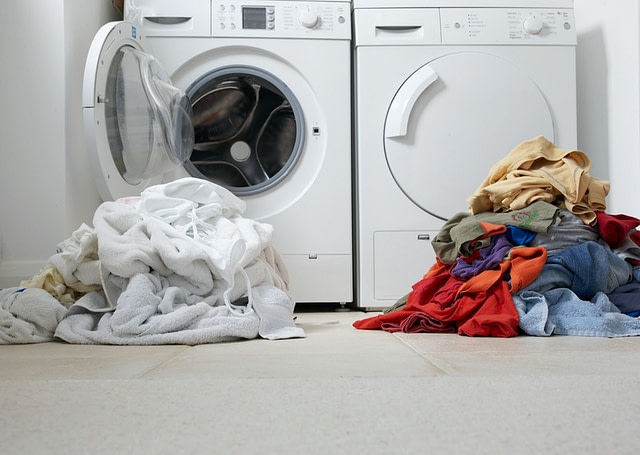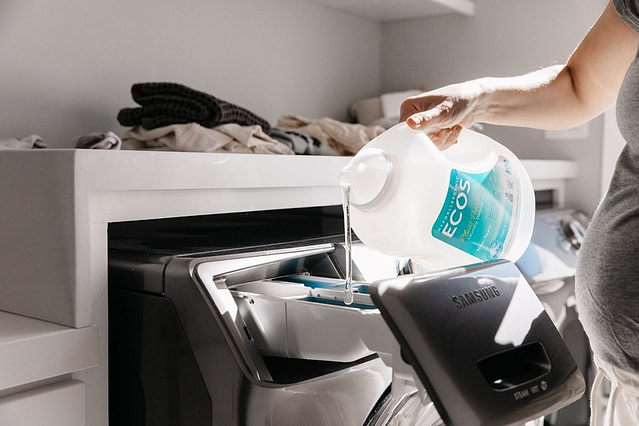How to Separate Laundry (and Other Secrets to Laundry Success)
7 Minute Read

Sometimes our days require quick thinking and a change of clothes—or three. First, you have morning yoga, then work, then lunch and an afternoon coffee run. Even after all that, there’s still a stop at soccer practice, a dinner with your parents, and a late-night Target run before you finally get to slip on your pajamas and slide into your long-awaited sheets.
That’s a lot of wardrobe changes, and before you know it you have a mountain of multicolored clothes, which, of course, leads us to your weekend agenda: figuring out how to separate laundry.
Knowing how to separate all the different colors and fabrics in your laundry is a special skill—but one that’s essential to keeping your clothes bright and your fabrics lasting longer. Luckily, we have the tips to help make your laundry day successful, from separating your lights and darks to choosing the best eco-conscious laundry detergent.
How to Properly Separate Laundry
The trick to keeping your garments and linens in top condition is knowing when and how to wash them and which pieces can be washed together.
Fortunately, separating your laundry and sorting clothes isn’t difficult. Generally, it can be accomplished in four easy steps, which we’ll go through below:
- Read the label
- Separate by fabric and type
- Separate by color
- Separate by soil level
Properly categorizing and separating your laundry using these four steps ensures that every last sock, tee, towel, and sheet stays crisp and vibrant as long as possible.
Step 1: Read the Label
Did you know that most pieces of clothing actually come with their own how-to manual of washing instructions? That’s right—that tiny label sewn into your clothing contains all the secrets to keeping your clothing in prime condition during the wash cycle.

Care labels indicate several important facts about your garment, including:
- Fabric type and content
- Machine wash temperature
- Bleach tolerance
- Ironing guidelines
- Recommended dryer cycle
- Dry cleaning or hand-washing necessity
Most of these facts are even depicted in international laundry care symbols (those mysterious circles, triangles, and squares) that you can take in at a glance with a little study and practice.
One factor we can go ahead and cross off that list? Machine wash temperature. Thanks to advances in detergent and washer technology, nearly all laundry can be done using cold water. This also has the double benefit of saving electricity and extending the lifespan of your clothing and washables.
As you start to sort that mountain into several smaller piles of clothes, it’s vital that you first check that an item can tolerate machine washing. If the care label indicates Hand Wash or Dry Clean Only, put the item aside to drop off at your local dry-cleaner (preferably an eco-conscious one), or to wash it by hand.
For the remaining items, move on to step two.
Step 2: Separate by Fabric or Type
Just like you organize your wardrobe to help you choose the most appropriate pairings for your daily activities, you’ll also need to classify which of your washables go together based on fabric type. This doesn’t mean that you need to scrutinize the exact fabric content or use of each item. Instead, we suggest you separate your machine-washable laundry into these broad groupings of different fabrics:
- Bed linens and towels – Because of their size (and tendency to twist and tangle around your smaller clothes), it’s best to wash bulky items separately.
- Denim – Can denim jeans be paired with (gasp) a denim shirt? The question on how to wash it is just as contentious. However, a few things are certain. You’ll want to turn them inside out and wash on delicate with cold water. It’s also a good idea to wash them separately. Due to their heavy fabric and tendency to hold water and shed indigo dye, jeans and other denim items can affect your other clothing.
- Delicates and knits – Machine washing delicate items and knits runs the risk of stretching the fabric out of shape, or even snagging and tearing them on other items. To prevent this, we advise that you always wash your delicates and knits in a mesh washing bag, separate from other items, and on your machine’s gentlest cycle.
- Activewear – We like to wash activewear with an enzyme detergent like ECOS Hypoallergenic Laundry Detergent with Enzymes that will help break the bonds of the oil and grime on the inner surfaces.
- Casual – This pile will likely be your largest each week, with everything from your PJs and tees to those cute animal print socks and that pair of sweatpants you can’t wait to put on every day. Your casual laundry also includes everyday clothes like khakis, sweatshirts, cotton jackets, and durable synthetic clothing. Usually, these items can be washed on a regular machine setting.

Step 3: Separate by Color
Want whites like snow and brights that don’t fade? Separating your clothes by color is the golden ticket to keeping those not-so-welcome color changes from happening inside the washer.
Generally, this step applies only to casual clothing since it’s your largest and most diverse pile. But to keep those color tones as on-point as your sense of style, knowing how to wash white clothes and how to wash colored clothes are both very important steps to understand before putting them in the washing machine.
- Whites – This means pure white items, not pale shades of colors. (Don’t worry, there’s a place for them too.)
- Lights – This load will contain your pale and pastel clothing. Though these do have some pigment, the lighter hues mean they can’t share a load with brights or dark clothes that might transfer color into the wash water.
- Brights and darks – In general, brights and darks can be washed together. The caveat for how to wash colored clothes is that you should always wash a bright or dark item alone the first time to make sure most excess dye is out of the fabric.
Step Four: Separate by Soil Level
The next step is to pull out any items that have been soiled.
- Heavy soil – These items are extra dirty and might benefit from pre-soaking, spot-treating, or an extra rinse cycle to remove:
- Mud
- Dirt
- Blood
- Oils
- Regular soil – This is everything else. Easy, right?
Make sure you look into how to get oil stains out of clothes along with any other stubborn stains that fall into the heavy soil category before you throw them into the washing machine, such as by pre-treating them with our ECOS OxoBrite Multi-Purpose Stain Remover.
It’s Sorted! Now What?
Once your laundry is sorted, you can begin washing. This sounds easy, but between your washer’s various cycles, speeds, and temperatures (and your dryer’s multitudinous spaceship-like settings), it can start to feel overwhelming.
While you should always refer to your garment label, here are some general laundry guidelines:
- Detergent – While there are loads of detergents out there to choose from, your best bet is to choose something that’s kind to your clothes—as well as your skin and the environment. We like our ECOS Hypoallergenic Laundry Detergent with Enzymes for when things get extra messy, and our ECOS Plant-Powered Laundry Detergent Sheets are your go-to for an easy-to-use, zero waste option.
- Cycle speed and length – For most laundry, a regular cycle length and speed are appropriate. However, always use a low or delicate setting for your knits and delicates.
- Dryer time and temperature – While spending some time in a sauna might sound like a dream most of us, the dryer is where most of your clothes get damaged. Taking your wash out as soon as it’s dry, whether it is a towel dried on hot or a delicate dried on low, is essential to preserving the fabric at its peak (and avoiding extra wrinkles from waiting too long).

Other tips that will help you maximize your washing and drying power are:
- Turn items inside out before you throw them in the hamper
- Pre-sort laundry using a partitioned hamper
- Always pre-treat stains
- Use a mesh bag for delicates
- Wash full loads to save energy
- Line dry when possible
- Wash in cold water to reduce up to 90% of energy
- Wash during off-peak times (before 4 pm or after 7 pm)
- Clean your dryer’s lint trap after every load, allowing it to work faster and use less electricity
Choosing a Detergent That’s Safer for You, Your Clothes, and the Environment
Before you head out to buy laundry detergent and complete your transformation into a laundry separating genius, you should know which ingredients to avoid, too.
Some common detergents contain chemicals that can be toxic and irritating to both us and the environment, including:
- Dyes
- 1,4-dioxane
- Chlorine bleach
- Optical brighteners
- Formaldehyde
Instead, choose something that’s skin-safe and eco-conscious, like laundry detergents from ECOS.
ECOS Detergents for a Safer Clean
We’ve been committed to creating eco-conscious cleaning products for over 50 years. Our laundry detergents are made with our formula is 100% vegan formulas to get you the best wash while still keeping our planet safe from harmful ingredients. In fact, we’ve even created a list of over 500 harmful chemicals to watch out for, called The Nasties.
